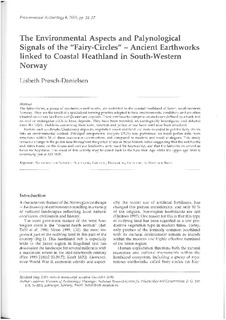The environmental aspects and palynological signals of the “fairy circles” : ancient networks linked to coastal heathland in south-western Norway
Journal article, Peer reviewed
Permanent lenke
http://hdl.handle.net/11250/181535Utgivelsesdato
2001Metadata
Vis full innførselSamlinger
- Articles (AmS) [145]
Originalversjon
Prøsch-Danielsen, L. (2001). The environmental aspects and palynological signals of the “fairy circles” : ancient networks linked to coastal heathland in south-western Norway, Environmental Archaeology, 6, 39-57Sammendrag
The fairy-circles, a group of mysterious earthworks, are restricted to the coastal heathland of Jæren, south-western Norway. They are the result of a specialised farming practice adapted to local environmental conditions and are often situated on convex landforms of Quaternary deposits. These earthworks comprise an enclosure defined by a bank and an oval or a rectangular ditch in loose deposits. They have been recorded, archaeologically investigated and debated since the 1820s. Problems concerning their form, function, and period of use have until now been unsolved. Factors such as climate, Quaternary deposits, vegetation cover and land-use were recorded to put the fairy-circles into an enviromental context. Principal components analysis (PCA) was performed on fossil pollen data from structures within 16 of these man-made constructions and compared to modern and fossil analogues. This study reveals a change in the pollen taxa throughout the period of use of these historic relics suggesting that the wet heaths and mires found on the slopes and concave landforms were used for haymaking, and that the fairy-circles served as bases for haystacks. The onset of this activity may be dated back to the Late Iron Age while the upper age limit is tentatively put at AD 1835.
Beskrivelse
Reproduced with permission. Copyright belongs to Maney Publishing: www.maneypublishing.com/journals/env, www.ingentaconnect.com/content/maney/env
